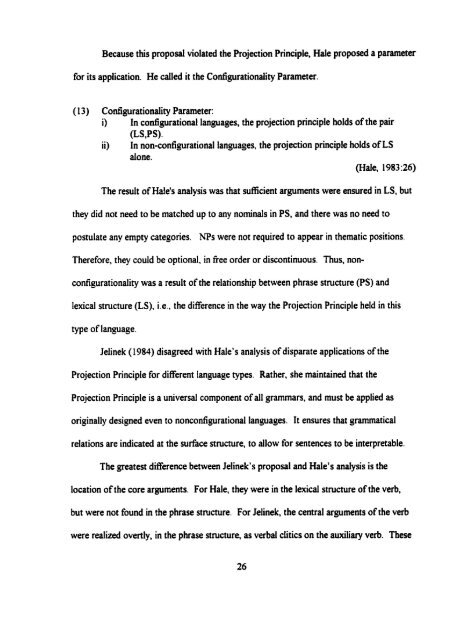Adverbial and Argument-Doubling Clauses in Cree - MSpace
Adverbial and Argument-Doubling Clauses in Cree - MSpace
Adverbial and Argument-Doubling Clauses in Cree - MSpace
Create successful ePaper yourself
Turn your PDF publications into a flip-book with our unique Google optimized e-Paper software.
Because this proposal violated the Projection Pr<strong>in</strong>ciple, Hale proposed a parameter<br />
for its application. He called it the Configurationality Parameter.<br />
( 13) Configurationality Parameter:<br />
i) In contigurational languages, the projection pr<strong>in</strong>ciple holds of the pair<br />
ii)<br />
(LS,PS).<br />
In non-configurational languages, the projection pr<strong>in</strong>ciple holds of LS<br />
aione.<br />
(Hale, 1983 :26)<br />
The result of Haie's analysis was that sufficient arguments were ensured <strong>in</strong> LS, but<br />
they did not need to be matched up to any nom<strong>in</strong>ais <strong>in</strong> PS. <strong>and</strong> there was no need to<br />
postulate any empty categories. NPs were not required to appear <strong>in</strong> thematic positions.<br />
Therefore, they could be optional, <strong>in</strong> fiee order or discont<strong>in</strong>uous. Thus, non-<br />
configurationality was a result of the relationship between phrase structure (PS) <strong>and</strong><br />
lexical structure (LS), Le., the difference <strong>in</strong> the way the Projection Pr<strong>in</strong>ciple held <strong>in</strong> this<br />
type of language.<br />
Jel<strong>in</strong>ek (1 984) disagreed with Hale's analysis of disparate applications of the<br />
Projection Pr<strong>in</strong>ciple for different language types. Rather, she ma<strong>in</strong>ta<strong>in</strong>ed that the<br />
Projection Pr<strong>in</strong>ciple is a universal component of al1 grammars, <strong>and</strong> must be applied as<br />
orig<strong>in</strong>ally designed even to nonconfigurational languages. It ensures that grammatical<br />
relations are <strong>in</strong>dicated at the surface structure, to allow for sentences to be <strong>in</strong>terpretable.<br />
The greatest difference between Jel<strong>in</strong>ek's proposal <strong>and</strong> Hale's analysis is the<br />
location of the core arguments. For Hale, they were <strong>in</strong> the lexical structure of the verb,<br />
but were not found <strong>in</strong> the phrase structure. For Jel<strong>in</strong>ek, the central arguments of the verb<br />
were realized overtly, <strong>in</strong> the phrase structure, as verbal clitics on the awÿliary verb. These








![an unusual bacterial isolate from in partial fulf]lment for the ... - MSpace](https://img.yumpu.com/21942008/1/190x245/an-unusual-bacterial-isolate-from-in-partial-fulflment-for-the-mspace.jpg?quality=85)




![in partial fulfil]ment of the - MSpace - University of Manitoba](https://img.yumpu.com/21941988/1/190x245/in-partial-fulfilment-of-the-mspace-university-of-manitoba.jpg?quality=85)


